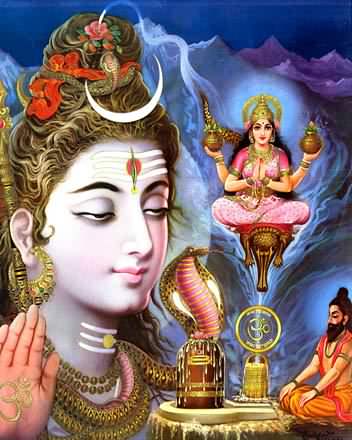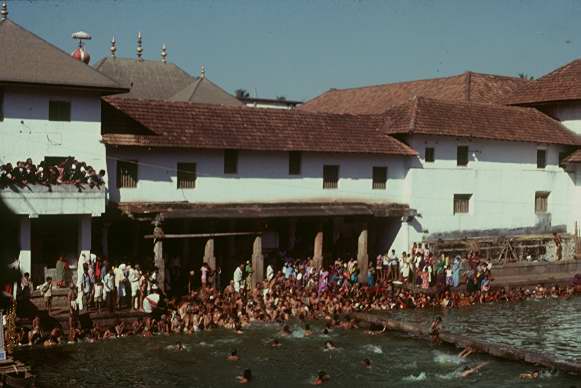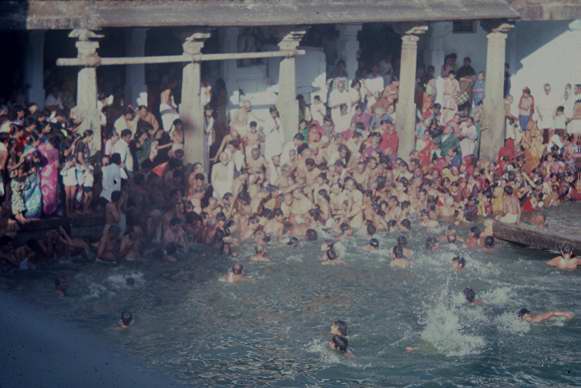
Jahnu Saptami:
You will gain the best results viewing this page using Balaram font

On this day the Ganga is worshipped and many people make
offerings to the forefathers, and bathe in the Ganga. On this day, if possible,
one should worship the Ganges and bathe in her waters.
From Bhaktivinode Thakura's Sri Navadvipa Mahatmya Chapter 13: Description of Vidyanagara and Jahnudvipa
As Nityananda spoke, they went to Jannagara where they saw the enchanting hermitage of Jahnu Muni. Nityananda Prahhu explained, "This enchanting place named Jahnudvipa is known as Bhadravana. At this place, Jahnu Muni underwent penances and received darsana of the golden form of Gauranga.
"Jahnu Muni was sitting here chanting his gayatri mantra, when his acamana cup fell into the Bhagirathi (Ganges) and was swept away by the currents. He opened his mouth and drank all the water in one gulp. King Bhagiratha thought, 'Where has the Ganges gone?' He concluded that Jahnu Muni had drunk the Ganges. The king was overwhelmed with anxiety and worshipped the muni for several days. The muni then released the Ganges from his body. Because of this incident the Ganges is known as Jahnavi, the daughter of Jahnu, throughout the world."
Origin of the Ganges River from www.gosai.com
Once, long ago, a king named Bali Maharaja conquered all the planets in the universe. Ousting the demigods, the deputed managers of universal affairs, from their heavenly domains, Bali Maharaja installed himself as king of the celestial realm. Aditi, the mother of the demigods, being aggrieved at her sons' defeat, fasted and prayed to Vishnu (God) for twelve consecutive days. Pleased with Aditi, Vishnu agreed to reinstate the demigods by incarnating as Vamanadeva, a dwarf brahmana mendicant (saintly priest).
Vamanadeva approached Bali Maharaja and begged him for three paces of land. When Bali agreed, Vamanadeva expanded His form to gigantic proportions and covered the entire universe with His first step, thus reclaiming the demigods lost property. With His second step, Vamanadeva kicked a hole in the universal shell with His toe, causing a few drops of water from the spiritual world to leak into the universe. This water flowed into the universe and became known as the Ganges River. The Ganges is thus considered sacred because it originated from the spiritual world and because it touched the toe of Vamanadeva, the incarnation of Vishnu.
Originally, the Ganges flowed only in the heavenly planets. Then a great king of ancient India, named Bhagiratha, desired to have the Ganges purify the earth and prayed for the river to descend. The personified Ganges, mother Gangadevi, appeared before King Bhagiratha and agreed to fulfill his desire, but she had two reservations. First, she hesitated to come to earth because she feared that many sinful people would bathe in her waters and contaminate her with bad karma. King Bhagiratha then assured Gangadevi that although many sinful persons would bathe in her waters, many saintly persons who can purify even places of pilgrimage would also bathe there, thus purifying her of all karmic contaminations.
Secondly, Gangadevi said: "When I fall from the sky to the surface of the planet earth, the water will be very forceful. Who will sustain that force? If I am not sustained, I shall pierce the surface of the earth and glide down to the lower regions of the universe." To satisfy Gangadevi, King Bhagiratha prayed to Shiva, and when the king asked the great demigod to catch the falling Ganges water on his head, he agreed to the request. Since that time, Shiva has been sustaining the Ganges on his head, and her sacred water has been flowing on the earth, purifying all those who come in contact with them. (Tripurari Swami. Sanga newsletter)
Srimad Bhagavatam Ninth Canto
Chapter Fifteen
Chapter Title: Paraçuräma,
the Lordís Warrior Incarnation
SB 9.15 Summary
This chapter describes the history
of Gädhi in the dynasty of Aila.
From the womb of Urvaçé
came six sons, named Äyu, Çrutäyu, Satyäyu, Raya,
Jaya and Vijaya. The son of Çrutäyu was Vasumän, the son
of Satyäyu was Çrutaïjaya, the son of Raya was Eka, the
son of Jaya was Amita, and the son of Vijaya was Bhéma. Bhémaís
son was named Käïcana, the son of Käïcana was Hotraka,
and the son of Hotraka was Jahnu, who was celebrated for having drunk all
the water of the Ganges in one sip. The descendants of Jahnu, one after
another, were Puru, Baläka, Ajaka and Kuça. The sons of Kuça
were Kuçämbu, Tanaya, Vasu and Kuçanäbha. From
Kuçämbu came Gädhi, who had a daughter named Satyavaté.
Satyavaté married Åcéka Muni after the muni contributed
a substantial dowry, and from the womb of Satyavaté by Åcéka
Muni, Jamadagni was born. The son of Jamadagni was Räma, or Paraçuräma.
When a king named Kärtavéryärjuna stole Jamadagniís desire
cow, Paraçuräma, who is ascertained by learned experts to be
a saktyäveça incarnation of the Supreme Personality of Godhead,
killed Kärtavéryärjuna. Later, he annihilated the kñatriya
dynasty twenty-one times. After Paraçuräma killed Kärtavéryärjuna,
Jamadagni told him that killing a king is sinful and that as a brähmaëa
he should have tolerated the offense. Therefore Jamadagni advised Paraçuräma
to atone for his sin by traveling to various holy places.
(A.C. Bhaktivedanta Swami Prabhupada.
Srimad Bhagavatam Summary to Ninth Canto chapter 15.)
On this day commemorating the event's annirversary, the Ganga is worshipped and many people make offerings to the forefathers, and bathe in the Ganga.
In Udupi where they have a Deity of Bhagirathi maharaj by the side of the Madhwa Sarovar inside the Krishna Mutt compound they have a nice festival on this day.
 ...
...
More about the Ganges - Ganga
puja etc.
